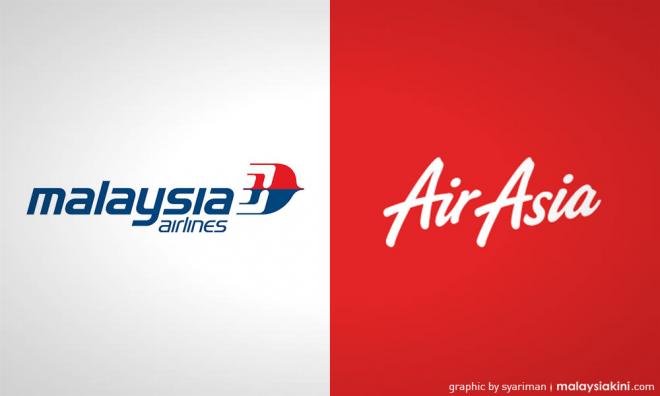
Published by Malay Mail, Focus Malaysia & Business Today, image from Malaysiakini.
One contributing factor for Malaysia Airlines Berhad’s (MAB) struggles was competition from the low-cost-carrier (LCC) AirAsia group. Given that the pandemic has hit both companies badly, the future of Malaysia’s aviation connectivity may be at stake and the current market calls for an alternative to the competition, such as a strategic merger between the traditional rivals.
The merger has the potential to leverage management and strategic expertise from both companies. According to the Centre for Aviation (CAPA), despite AirAsia coming into the scene only in 2003, it not only surpassed MAB to become the largest airline in Malaysia but also one of the largest in Asia.
AirAsia’s experience in managing airlines and its expertise in low-cost formulas are exemplary and may benefit a merger with MAB, which has been reported to be relatively less cost-efficient. AirAsia was awarded the “World’s Best Low-Cost Airline” for 11 consecutive years at Skytrax World Airline Awards 2019.
Malaysia Airlines’ experience in providing high-class full carrier services can add value to the merger as well. According to CAPA, Malaysia Airlines was given the “5-star airline” rating and was the first airline to be consecutively awarded with the “World’s Best Cabin Crew” by Skytrax UK.
Nevertheless, Malaysia Airlines has struggled to cut costs. The difference between Malaysia Airlines and AirAsia in terms of cost efficiency and productivity can be observed through a 2006 paper (around the time when AirAsia was still relatively young in the aviation scene) whereby researchers from Universiti Putra Malaysia (UPM) mentioned that AirAsia had the world’s lowest unit cost per average-seat-kilometres (CASKs) — a way to measure the cost-efficiency of airlines.
Furthermore, according to the UPM research paper, AirAsia was reported to have hedged a 3-years-worth of all of its fuel needs which was in stark contrast to the 20 per cent hedging by Malaysia Airlines. The International Air Transport Association (IATA) reported that fuel bill accounts for 23.7 per cent of the operating expenses in the global airline industry in 2018. Thus, hedging is an important mitigation strategy against potential high fuel prices.
Relatedly, AirAsia went the distance in aircraft weight reduction strategies to reduce fuel consumption — reducing the amount of paper carried onboard such as flight plans, voyage reports, aircraft manuals and the documentation required by pilots.
As for productivity rate, the UPM research paper highlighted AirAsia’s level of crew productivity was three times more than Malaysia Airlines. AirAsia was also found to be better in aircraft turnaround times and average aircraft utilisation rate.
Another source of cost inefficiency could be MAB’s bloated procurement process. As reported in 2015, then CEO of MAB Christoph Mueller pointed to a “non-state-of-the-art” procurement process. Relatedly, as reported by The Edge Markets, Mueller mentioned to German media that when he came into MAB, the airline was paying above market value to its suppliers, which was up to 25 per cent higher.
Taking cue on these severe cost issues, MAB and its owner Khazanah took serious steps to improve its cost-cutting measures during its turnaround plan beginning 2014. As reported in The Edge Markets in 2019, Khazanah’s managing director Datuk Shahril Redza Ridzuan claimed that the airline’s CASK was only 15 per cent to 20 per cent higher than AirAsia and was in fact lower than regional airlines such as Singapore Airlines, Thai Airways and Cathay Pacific.
Despite MAB’s turnaround plan it was still not profitable, as pointed by The Edge Markets. Furthermore, the cost-cutting efforts came at the price of service quality and that MAB lost the five-star rating given by Skytrax during its turnaround efforts.
In addition to managing costs without sacrificing service quality — which is probably something that AirAsia’s experience could add value to — a consolidation of market rivals combined with a business plan for better cost management and improved economies of scale could be the way to go.
This makes sense given claims of market over-capacity. Shahril reportedly opined that the local market size of 30 million people is too small given the oversupply contributed by Malaysia Airlines, AirAsia, and Malindo.
On this matter, The Malaysian Reserve reported Tony Fernandes pointing to ample growth potential in the low-cost market, instead of the widely claimed oversupplied market. This could be hinting at MAB’s struggles to compete in the LCC market and that it should’ve stick to its strengths in higher-end full carrier services.
In any case, market size remains an important consideration given that the merger of AirAsia and MAB would make it Malaysia’s largest airline and one of the biggest in the region, as pointed in aviation news and insights portal Simple Flying. Given the supressed current markets, the merger’s rationalisation plan may require it to downsize, but at the same time open up opportunities in fleet reshuffling as part of its new business plan.
As pointed by CAPA, widebody aircrafts are not suited for flight services with the combination of low-cost, high-frequency and short-hauls — the usual scenario for point-to-point model of flight paths.
Therefore, MAB’s fleet of widebody aircrafts may be focused on long-haul, full-service flights and higher-end markets prioritised for the hub-and-spoke model of flight paths.
On the other hand, AirAsia’s fleet of Airbus A320 narrow-body aircraft may focus on domestic and regional destinations using the point-to-point model.
This could make sense for AirAsia given its closure of AirAsia X which cover longer-distance flights and could be a way to utilise MAB’s fleet of superjumbos. But it must be noted that industry expert Shukor Yusof — founder of aviation consultancy firm Endau Analytics — have cautioned on using airlines that are no longer in production or have no ‘secondary value’.
In line with the fleet reshuffling effort, the merger may present an opportunity to consolidate intangible assets such as landing rights to be fully utilised through the combined management and strategic expertise.
For example, the merger may allow access to landing rights and flight paths that are crucial to fully tap into the Islamic tourism market. The Mastercard-CrescentRating Global Muslim Travel Index 2019 estimated 140 million international Muslim visitors in 2018 with a projection of 230 million by 2026.
The Mastercard-CrescentRating Digital Muslim Travel Report 2018 estimated US$180 billion expenditure in 2026 for online travel purchases by Muslim travellers. Of course, these projections may have to be discounted to account for the uncertainty driven by the pandemic.
With gradual opening of borders following the vaccine outlook and news of travel bubbles that may be driven by the adoption of a digital health pass, the umrah and hajj markets may provide a lucrative market.
Relatedly, the merger exposes the new management on how best to improve existing initiatives such as the Amal project. As reported in The New Straits Times, this project focusses on umrah and haj pilgrims, which may also be an attempt to better utilise MAB’s fleet of A380s — notwithstanding concerns raised by Yusof.
However, in order for a new business plan to maximise the usage of widebody aircrafts or superjumbos and increase traveller volumes in Malaysia, an effort to revive Malaysia’s competitiveness in the hub-and-spoke model may be needed. While the local airline industry appears to face intense competition, the opposite could be said with Malaysia’s airport situation. This appears to be an overlooked and underestimated matter when it comes merger discussions.
The single operator system may need to be reviewed to ensure the business plan for the new merger can be well-supported. We may need stronger domestic airport competition to drive better services and better prices for travellers and for airline companies.
Ahmad Ameen Mohd Kamal and Nur Sofea Hasmira Azahar are part of the research team of EMIR Research, an independent think tank focused on strategic policy recommendations based on rigorous research.

